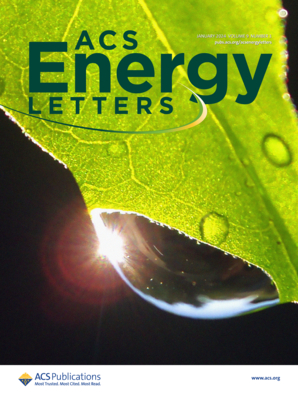使用 NaBO2-4H2O 烧结助剂在 400 °C 下烧结氧化物固态钠电池
IF 18.2
1区 材料科学
Q1 CHEMISTRY, PHYSICAL
引用次数: 0
摘要
本研究采用 NaBO2-4H2O (NBO2) 作为烧结助剂,成功地在 400 °C 下对 Na3.1Zr1.95Mg0.05(SiO4)2(PO4) (NZMSP) 固体电解质进行了致密化处理。与不含 NBO2 的样品相比,含有 20 wt % NBO2 的 NZMSP 固体电解质在 25 °C 时的总离子电导率为 3.3 × 10-4 S cm-1,并显示出更稳定的 Na 沉积/剥离循环。虽然用含有 20 wt % NBO2 的 NZMSP 烧结的 Na3V2(PO4)3(NVP)活性材料在烧结后会分解,但含有 1 或 5 wt % NBO2 的 NVP 大部分仍然完好无损。含有 5 wt % NBO2 的 Na/NZMSP/NVP 电池在 1.0-4.0 V 对 Na+/Na 的电压下显示出 171 mAh g-1 的初始放电容量,与 176.4 mAh g-1 的理论容量相当。此外,含有 5 wt % NBO2 的对称 NVP/NZMSP/NVP 电池的初始放电容量为 70.4 mAh g-1。这项研究表明,使用 NBO2 烧结辅助剂可以低成本、低温制造氧化物固态钠电池。本文章由计算机程序翻译,如有差异,请以英文原文为准。

Oxide Solid-State Sodium Batteries Sintered at 400 °C Using an NaBO2·4H2O Sintering Aid
In this study, a Na3.1Zr1.95Mg0.05(SiO4)2(PO4) (NZMSP) solid electrolyte is successfully densified at 400 °C by employing NaBO2·4H2O (NBO2) as a sintering aid. The NZMSP solid electrolyte containing 20 wt % NBO2 shows a total ionic conductivity of 3.3 × 10–4 S cm–1 at 25 °C and demonstrates more stable Na deposition/stripping cycles compared with samples without NBO2. Although the Na3V2(PO4)3 (NVP) active material sintered with NZMSP containing 20 wt % NBO2 decomposes after sintering, NVP with 1 or 5 wt % NBO2 remains mostly intact. An Na/NZMSP/NVP battery containing 5 wt % NBO2 exhibits an initial discharge capacity of 171 mAh g–1 at 1.0–4.0 V vs Na+/Na, which is comparable to the theoretical capacity, 176.4 mAh g–1. Additionally, a symmetric NVP/NZMSP/NVP battery containing 5 wt % NBO2 is operated with an initial discharge capacity of 70.4 mAh g–1. This study demonstrates that the NBO2 sintering aid enables cost-effective, low-temperature fabrication of oxide solid-state sodium batteries.
求助全文
通过发布文献求助,成功后即可免费获取论文全文。
去求助
来源期刊

ACS Energy Letters
Energy-Renewable Energy, Sustainability and the Environment
CiteScore
31.20
自引率
5.00%
发文量
469
审稿时长
1 months
期刊介绍:
ACS Energy Letters is a monthly journal that publishes papers reporting new scientific advances in energy research. The journal focuses on topics that are of interest to scientists working in the fundamental and applied sciences. Rapid publication is a central criterion for acceptance, and the journal is known for its quick publication times, with an average of 4-6 weeks from submission to web publication in As Soon As Publishable format.
ACS Energy Letters is ranked as the number one journal in the Web of Science Electrochemistry category. It also ranks within the top 10 journals for Physical Chemistry, Energy & Fuels, and Nanoscience & Nanotechnology.
The journal offers several types of articles, including Letters, Energy Express, Perspectives, Reviews, Editorials, Viewpoints and Energy Focus. Additionally, authors have the option to submit videos that summarize or support the information presented in a Perspective or Review article, which can be highlighted on the journal's website. ACS Energy Letters is abstracted and indexed in Chemical Abstracts Service/SciFinder, EBSCO-summon, PubMed, Web of Science, Scopus and Portico.
 求助内容:
求助内容: 应助结果提醒方式:
应助结果提醒方式:


